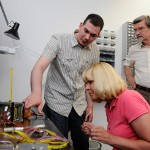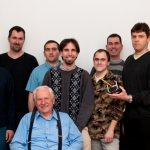In September 2007 a group of enthusiastic undergraduate and PhD students at BME decided to design and build a small satellite. The initiative was encouraged by two departments of BME, the Department of Electron Devices and the Department of Broadband Infocommunications and Electromagnetic Theory, and also by the BME Space Research Group.
The objectives of the initiative
- to train qualified engineers, who can support the existing domestic space industry
- to enable the developers to gain experience and obtain references in the design, implementation and operation of space devices, as such mission is unprecedented in Hungary
- to demonstrate Hungary’s aptitude in the design and implementation of space devices
- to set up a new technology baseline which enables the acceptance, launch and operation of not only our but also other professional domestic laboratories’ scientific experiments



The Team and the Flight Model of Masat-1
Besides, we also wanted to feed the obtained knowledge and experience back into education, to maintain the continuous training which is essential in this sector. Within the project students can receive university credits for their contributions, meaning that these activities are an integral part of their regular curriculum.
It was of high priority to perform all of the design and most of the production in Hungary, accrediting the suitability of domestic designers and manufacturers.
Another aim was to boost Hungary’s chances in the space industry sector and also to promote Hungary’s admission to the ESA with the provision of specialized, experienced and educated engineers. New international projects might be made available by the engineers who have been involved in the training and the project, meaning that the number of those involved in the sector (now a few hundred people in Hungary) might increase by a magnitude, increasing the annual revenue of the sector.
The objectives of the Masat-1 project
- To design and implement the basic subsystems of a custom-built satellite.
- To gain experience in the leadership, logistics, testing and launch arrangement aspects of a complex space project, which are all essential to proceed to the next step.
Mission success criteria
- Minimum success
- A basic success criteria will be met if students design, build and test a satellite which can survive the launch process and the environment in space.
- Deliver a fully tested satellite to the launch site and get a successfully released acknowledgement from the launch vehicle.
- If the Ground Station operates reliably 24/7.
- Intermediate success
- Successfully receive telemetry packets from the satellite.
- Control the satellite operation modes via telecommands
- Correct and reliable operation of all satellite subsystems
- Full mission success
- Reception of all scientific data and telemetry of the satellite



Charles Simonyi (Space tourist) and Előd Both (Head of Hungarian Space Office) visiting the laboratory
Technological aim
- Design and develop every on-board electronics hardware and software in-house
- Design a single-point failure free electrical power system
- Six independent, high efficiency maximum power point tracker circuits
- Test a new communication system based on a single chip ISM band transceiver
- Test a telecommand/telemetry system based on ESA PUS.
- Design a single point failure free on-board computer and data acquisition system
- The data acquisition system must be capable of collecting, compressing and logging whole orbit data on multiple telemetry channel
- Design a semi-active attitude control system based on permanent magnets, hysteresis materials and electromagnets (2-axis)
- Test the stabilization algorithm
- Test analog sun angle sensors based on infrared detectors
- Monitor the attitude of the CubeSat using: 3-Axis gyroscope sensors, 3-Axis magnetometers and 3-Axis accelerometers



Bertalan Farkas (First Hungarian astronaut) visiting the team.